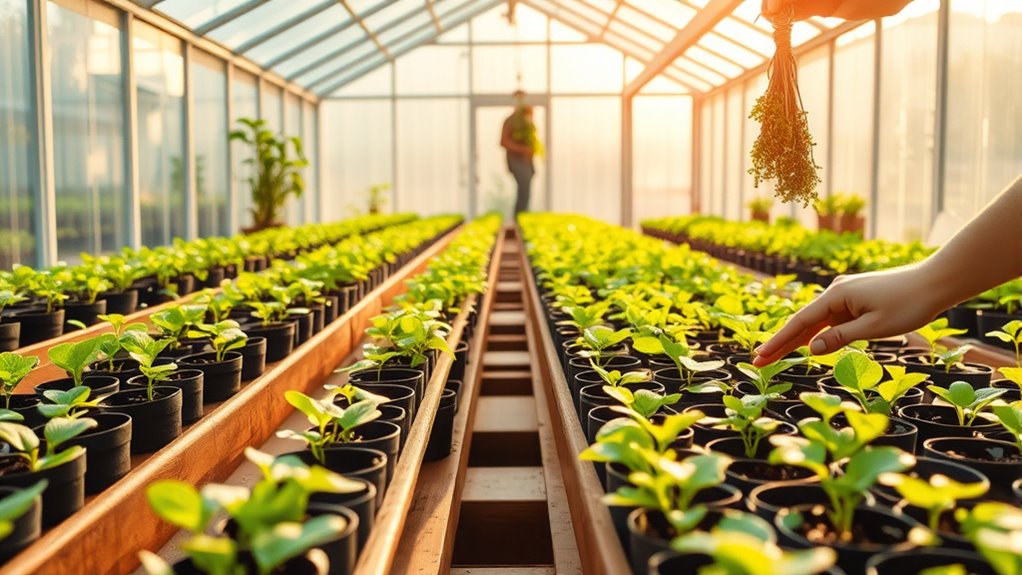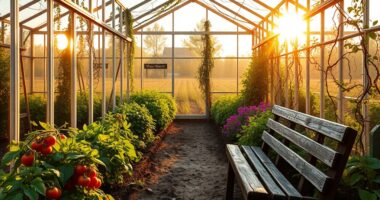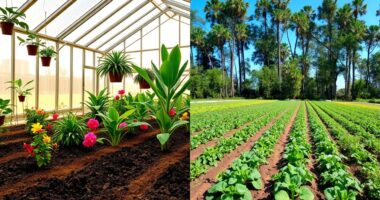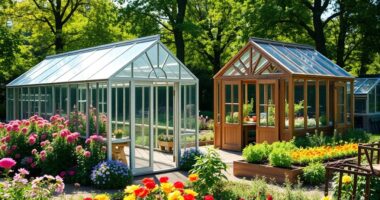Getting started with greenhouse gardening is simple if you focus on proper seed starting, maintaining a warm, well-lit environment, and using quality soil mixes. Keep your seedlings moist and ensure good airflow to prevent pests and diseases. Regular inspections and natural pest control methods like beneficial insects help protect your plants. Consistent care and monitoring will help you create a thriving greenhouse. If you keep exploring, you’ll discover more tips for a successful, year-round garden.
Key Takeaways
- Choose quality seed-starting trays and well-draining soil for healthy seedlings.
- Maintain consistent warm temperatures and ample light for optimal germination and growth.
- Regularly inspect plants for pests and introduce natural predators or organic repellents.
- Control humidity and airflow to prevent pests, diseases, and fungal issues.
- Develop a routine of monitoring and adjusting environmental conditions for thriving greenhouse plants.
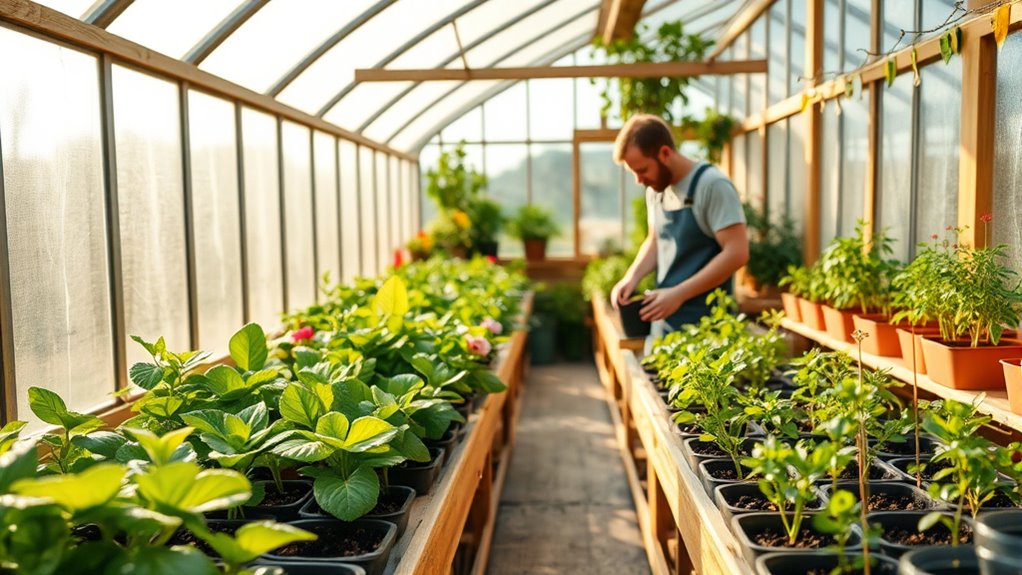
Starting a greenhouse garden can be an exciting way to grow plants year-round, even if you’re new to gardening. One of the first steps is understanding seed starting, which is vital for successful plant growth. Inside your greenhouse, you can control the environment, making it easier to germinate seeds and guarantee healthy seedlings. Use quality seed-starting trays filled with a light, well-draining soil mix. Keep the soil consistently moist but not waterlogged, and place the trays in a warm spot with plenty of light. As the seeds sprout, you’ll want to provide them with ample light, either from natural sunlight or grow lights, to encourage strong, healthy growth. This early stage is essential because healthy seedlings set the foundation for a productive garden.
Start your greenhouse garden by mastering seed starting with quality trays, light, and moisture for healthy seedlings.
Once your seedlings are established, pest control becomes a top priority. Greenhouses are enclosed spaces that can sometimes trap pests, so staying vigilant is key. Regularly inspect your plants for signs of pests like aphids, whiteflies, or spider mites. To keep these pests at bay, start with preventative measures such as introducing beneficial insects like ladybugs or adding natural repellents like neem oil. It’s important to act swiftly if you notice pests, as they can spread quickly and weaken your plants. Maintain good hygiene by removing dead leaves and debris, which can harbor pests and diseases. Proper airflow and ventilation also help prevent pest infestations by reducing humidity levels that pests thrive on.
Managing pest control in a greenhouse requires a balanced approach. Avoid heavy use of chemical pesticides, which can harm beneficial insects and compromise your plants’ health. Instead, focus on integrated pest management strategies that combine physical barriers, biological controls, and organic sprays. For example, placing insect screens over vents can prevent pests from entering, while introducing predatory insects helps naturally keep pest populations in check. Proper watering practices also help, as overwatering can create a damp environment that attracts pests and fosters mold or fungi.
Getting started with seed starting and pest control in your greenhouse might seem overwhelming at first, but with consistent monitoring and simple preventative steps, you’ll find it becomes second nature. Your greenhouse provides an excellent environment for nurturing young plants, and by staying attentive to their needs and potential problems, you’ll enjoy a thriving, productive garden all year round. With patience and care, you’ll develop a green thumb and create a lush space that produces beautiful, healthy plants in every season.
Frequently Asked Questions
What Are the Best Beginner-Friendly Greenhouse Materials?
When choosing beginner-friendly greenhouse materials, focus on options that are easy to work with and sustainable. Polycarbonate panels are great for their durability and excellent greenhouse ventilation, helping regulate temperature and humidity. They’re also lightweight and eco-friendly. Glass can be a good choice too, offering natural light, but it’s heavier. Consider sustainable materials like recycled plastics or bamboo for framing, making your greenhouse environmentally friendly and simple to maintain.
How Do I Control Pests in a Greenhouse Effectively?
Did you know that over 90% of greenhouse pests can be managed naturally? To control pests effectively, focus on organic pest control methods like neem oil or insecticidal soap. Additionally, try companion planting—pairing plants that repel pests with your crops. These simple strategies keep pests at bay without chemicals, ensuring healthy plants and a sustainable greenhouse environment. Start implementing these techniques today for pest-free gardening success!
What Are Common Mistakes to Avoid When Starting?
When starting, avoid common pitfalls like overwatering or underwatering, which can harm your plants. Don’t overlook the importance of proper ventilation and temperature control, as these are vital for healthy growth. Stay vigilant about pests and diseases, and don’t neglect regular maintenance. Rushing your setup or ignoring plant signals can lead to issues. Take your time, stay consistent, and learn from small mistakes to guarantee a thriving greenhouse.
How Much Does a Basic Greenhouse Setup Cost?
You might be surprised to find out that a basic greenhouse setup can cost anywhere from $500 to over $2,000, depending on size and materials. To stay on track, do some cost estimation and budget planning early. This way, you’ll prevent overspending and ensure your greenhouse fits your space and needs, making your gardening journey smoother from the very start.
Can I Grow Year-Round in a Greenhouse?
Yes, you can grow year-round in a greenhouse. By using season extension techniques, you protect your plants from harsh weather, allowing continuous growth. Focus on selecting hardy plants suited for each season, and consider adding heating or cooling systems as needed. With proper plant selection and climate control, your greenhouse becomes a perfect environment for year-round gardening, giving you fresh produce and vibrant blooms all year long.
Conclusion
Now, picture yourself stepping into your lush, thriving greenhouse, sunlight streaming through the glass, warmth wrapping around you like a gentle hug. With your hands in rich soil and vibrant plants reaching toward the sky, you feel confident and connected to nature. Greenhouse gardening isn’t just a hobby; it’s a rewarding journey. So, get started today, and watch your green sanctuary flourish with life, color, and growth, right in the comfort of your own space.
